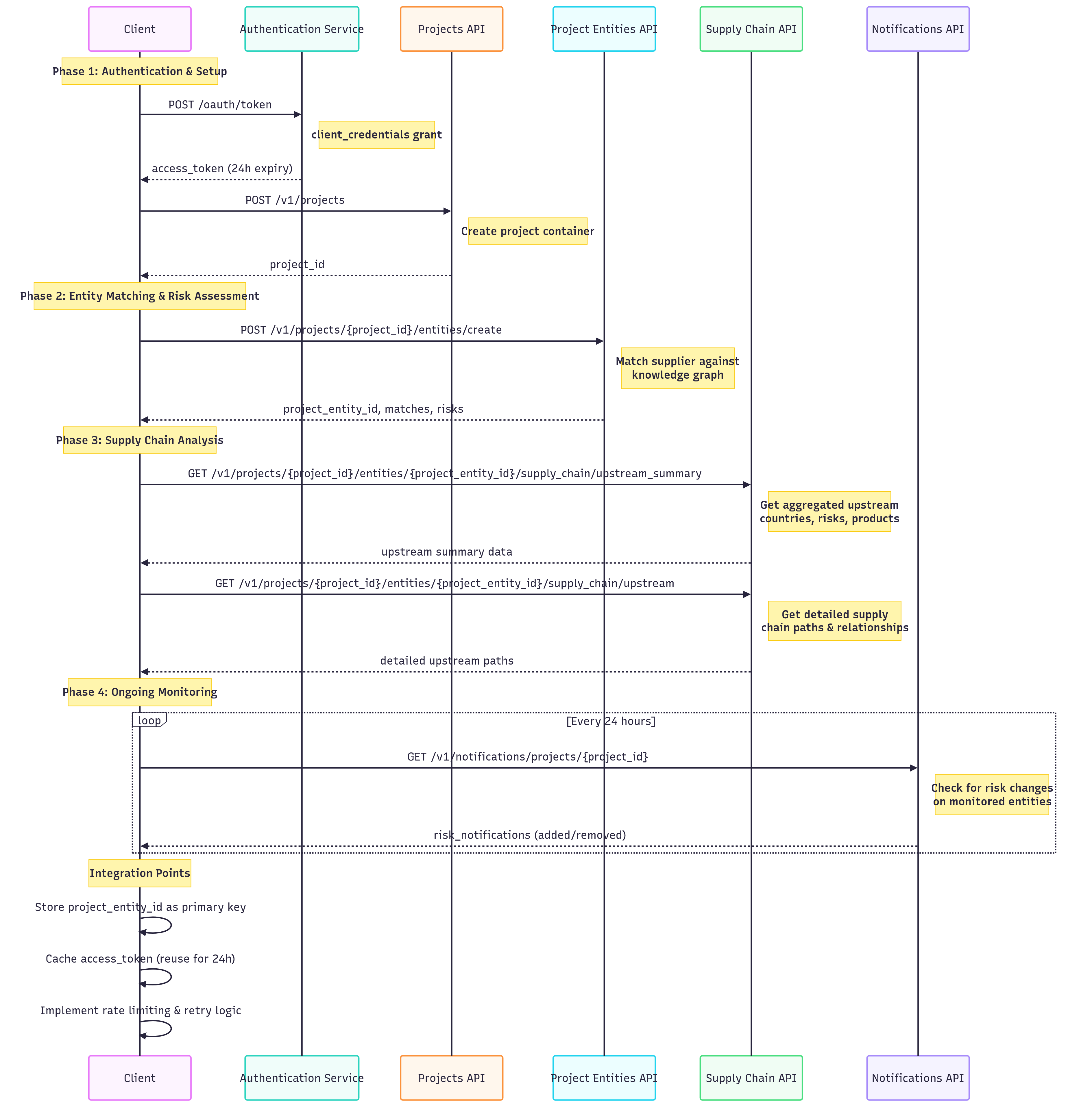

The Sayari API helps you monitor and assess risks in your global supply chain by:
A simple supply chain monitor that checks a single supplier for risks.
Prerequisites
client_id and client_secret)name, address, country)First, authenticate with the Sayari API to get a bearer token.
Token expires in 24 hours - Store it securely and reuse it
Create a project container to organize your supplier entities.
Key Response Fields:
id: this is the project_id we’ll reference this key in the following requestsMatch your supplier against Sayari’s database to identify potential risks.
Read our Understanding Project Entity guide to familiarize yourself with the core concepts of Project Entities.
To retrieve additional risk metadata such as descriptions, utilize the Get Risk Factors endpoint.
Key Response Fields:
project_entity_id: Use for supply chain queries and to reference the project entity in other API callsstrength: Match confidence (strong/partial/no_match)risk_categories: Array of risk categoriesrisk_factors: Detailed risk identifiersupstream.products: HS codes of products handled by supplierhas_upstream: Boolean indicating whether the supplier has upstream dataGet a high-level overview of your supplier’s entire supply chain, including countries, risks, and products.
Response contains:
upstream.countries: All countries in supply chainupstream.risk_categories: Categorized risks with factorsupstream.components: Product HS codes presentRetrieve specific supply chain paths with detailed trade relationships, dates, and locations.
Track risk changes on your monitored entities by polling the notifications endpoint.
Key Response Fields:
resource_id: This is your project_entity_idrisk_notifications.added: New risks detected for the entityrisk_notifications.removed: Risks that have been resolved or removedrisk_notifications.date: When the risk change occurredImportant Notes:
risk_notifications array, not the notifications arrayresource_id field corresponds to your project_entity_id
POST /v1/projects/{project_id}/entities/create - Find and match suppliers in Sayari’s knowledge graph
Input Requirements:
name - Company nameaddress - Physical addresscountry - ISO country code (e.g., KHM)identifier (optional) - Tax ID, registration numberKey Outputs:
project_entity_id - Unique identifier for API callsstrength - Match confidence (strong/partial/no_match)risk_categories - Categorized risk factorsupstream.products - HS codes of products handledGET /v1/projects/{project_id}/entities/{project_entity_id}/supply_chain/upstream_summary
Returns:
upstream.countries - All countries across supply tiersupstream.risk_categories - Risk factors by categoryupstream.components - Product HS codes presentGET /v1/notifications/projects/{project_id} - Check for risk changes on monitored entities
Polling Cadence:
Response Processing:
resource_id maps to project_entity_idrisk_notifications.added contains new risksrisk_notifications.removed contains resolved risksrisk_notifications.date shows when changes occurredIntegration Tips:
For a complete list of risk factors and their definitions, see the Risk Factor Table in our library documentation.
HS Codes are classifications used in international trade to identify specific products and materials. For more details, see the HS Codes endpoint. The endpoint currently accepts HS Codes up to 4 digits at the sub-chapter level.
Supply chain paths show the specific trade relationships and flow of goods from your supplier up through multiple tiers. Here’s how to read the path structure:
Each path represents a complete supply chain route from your matched supplier to upstream entities:
Supply chain tiers represent the distance from your supplier:
Each component represents a traded product or material:
Key Points:
hs_code identifies the specific product (e.g., “6004” = knitted fabrics)arrival_countries shows arrival countries / areas of importdeparture_countries shows departure countries / areas of exportExample Path Interpretation:
This tells us:
Last Updated: August 2025
Entity Screening & Verification